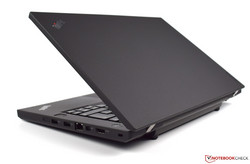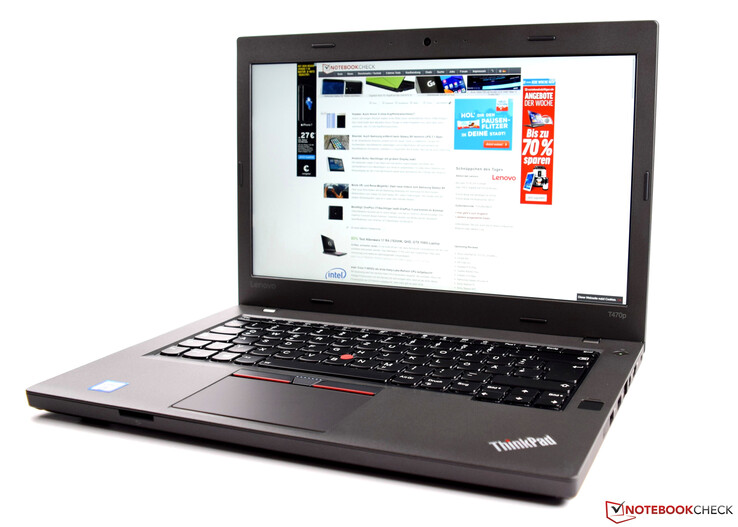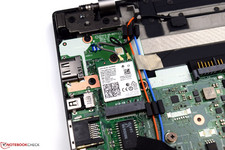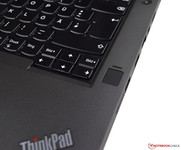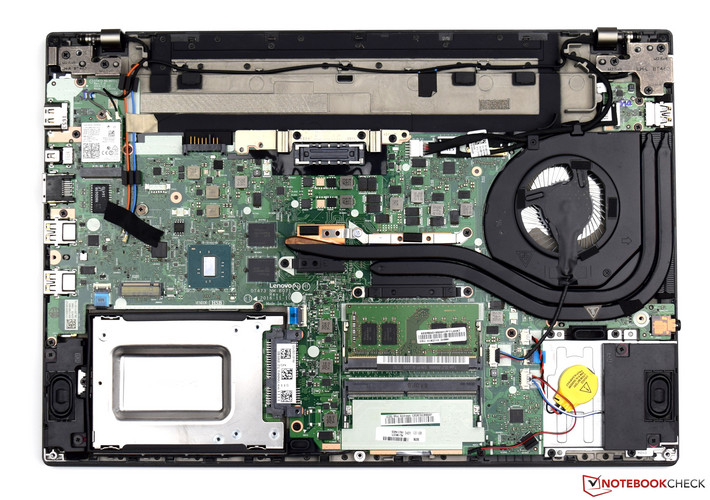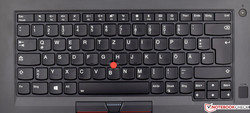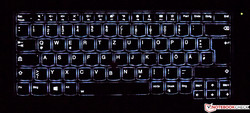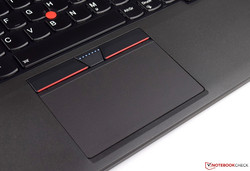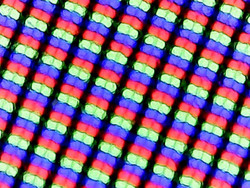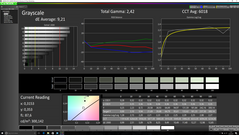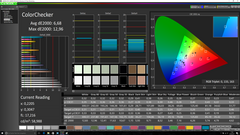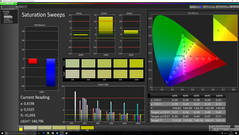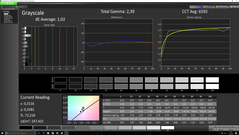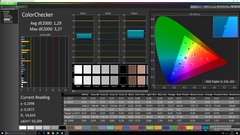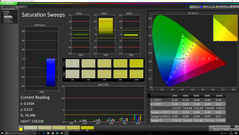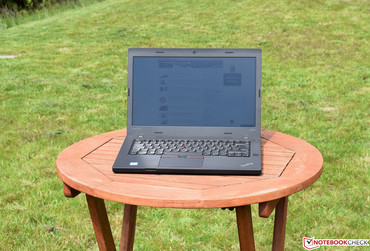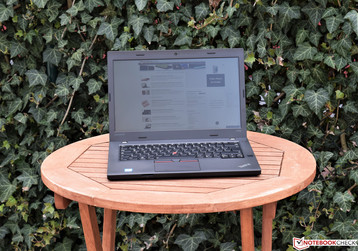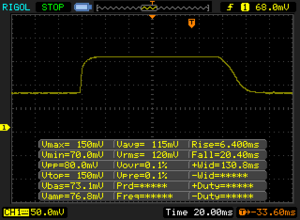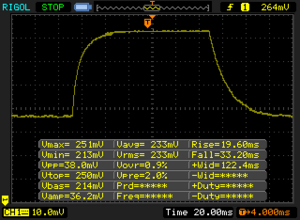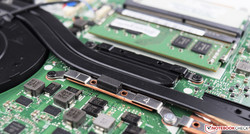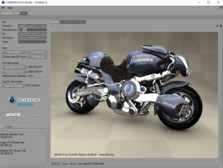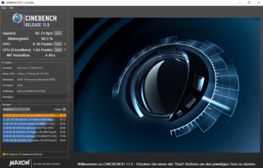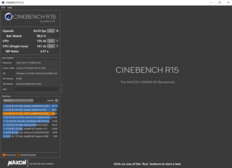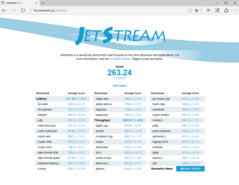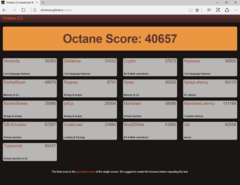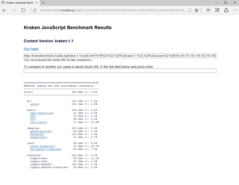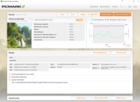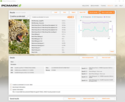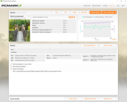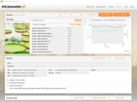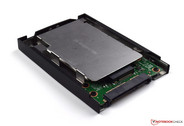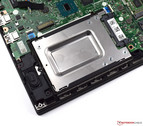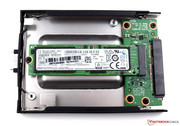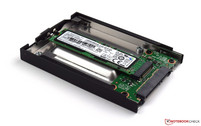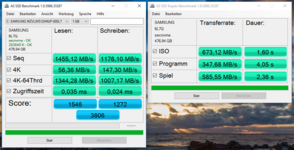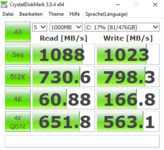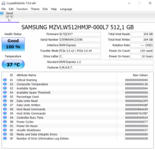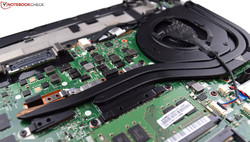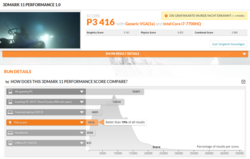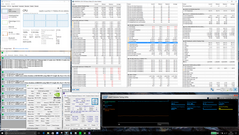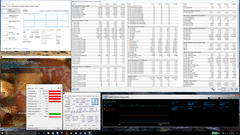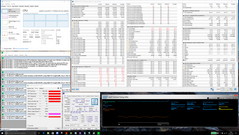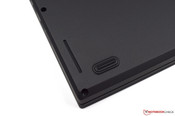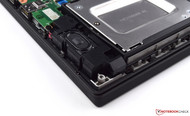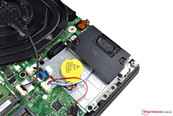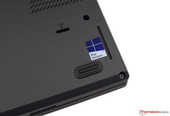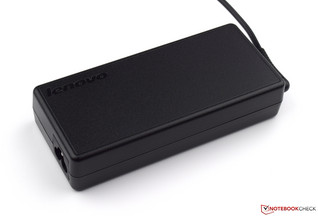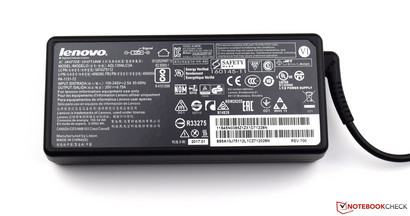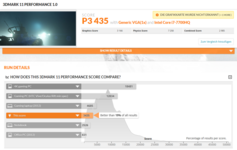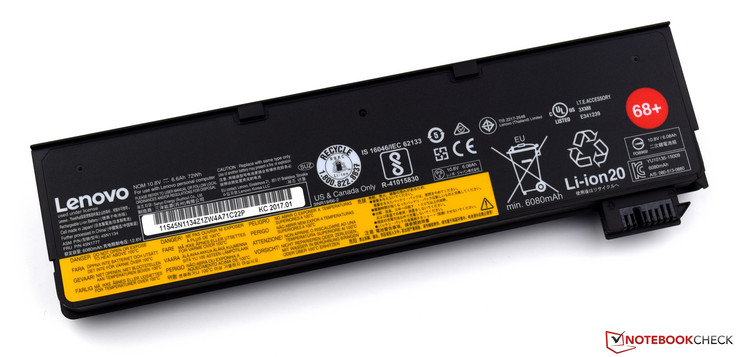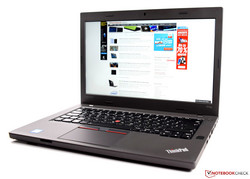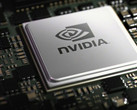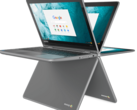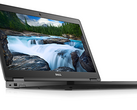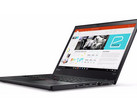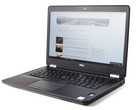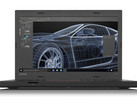Lenovo ThinkPad T470p (Core i7, GeForce 940MX) Laptop Review

For the original German review, see here.
It has been a year since we put the predecessor, the Lenovo ThinkPad T460p, through its paces. With the newly presented Lenovo ThinkPad T470p, the manufacturer simply updates the model. Now the basis is a modern Kaby Lake CPU, which is ahead of its predecessor by about 10% in terms of performance. The Lenovo ThinkPad T470p can be configured to your liking at the in-house shopping site. But for the entry model based on the Intel Core i5-7300U the manufacturer already asks for a hefty 1369 Euros (~$1544). In terms of the GPU and the RAM which is rather tight at 4 GB, the customers have to lower their sights.
It is also disturbing that only a conventional 500 GB hard drive is built into the most affordable device and only the Home version of Microsoft Windows 10 is offered. The varied configuration options are a strong advantage of the Lenovo ThinkPad T470p. The customer can choose between very frugal ULV processors with a 15-Watt TDP and very strong quad-core processors, which are rated at a TDP of up to 45 Watt.
The device can be configured easily, but the price quickly rises above the 1500-Euro mark ($1691). If it has to be a device with a strong Intel Core i7 like the features of our test unit, we reach a hefty 2099 Euros (~$2367; in the US, a model is available for $1350). One can do without the small things, but the bottom line still starts with a 2 in front. For this considerable price, the buyer receives a very fast Intel Core i7-7700HQ CPU and a dedicated Nvidia GeForce 940MX graphics GPU, and 8 GB of DDR4 RAM and a 512 GB SSD are the minimum offered in this configuration. As the choice of the battery, it comes with the large 72-Wh model to begin with. Optionally, a smaller 47-Wh battery is also available.
The Lenovo ThinkPad T470p does not lack any security features and our test unit is equipped with a multitude of them. As already mentioned, the Lenovo ThinkPad T470p clearly ranges in the high-price segment. Whether this is justified and how well our test unit fares against the competition (not only in-house), we will discuss during this test. Besides the in-house competition, the Lenovo ThinkPad T470p also has to compete against devices from Dell and HP. We present a table with the most important technical information of the comparison devices below.
| Lenovo ThinkPad T460p | Dell Latitude 14 E5470 | Dell Latitude 5480 | HP EliteBook 840 G4 | Lenovo ThinkPad T470 | |
| CPU | Intel Core i7-6700HQ | Intel Core i5-6440HQ | Intel Core i7-7600U | Intel Core i7-7200U | Intel Core i7-7200U |
| GPU | NVIDIA GeForce 940MX | Intel HD Graphics 530 | Intel HD Graphics 620 | Intel HD Graphics 620 | Intel HD Graphics 620 |
| Panel | 14 inch 2560 x 1440 | 14 inch 1920 x 1080 | 14 inch 1920 x 1080 | 14 inch 1920 x 1080 | 14 inch 1920 x 1080 |
| RAM | 8 GB DDR4-2133 | 8 GB DDR4-2133 | 8 GB DDR4-2400 | 8 GB DDR4-2133 | 8 GB DDR4-2400 |
| SSD | 512 GB | 256 GB | 256 GB | 256 GB | 512 GB, NVMe |
Case
Visually, the Lenovo ThinkPad T470p clearly fits into the ThinkPad series and directly corresponds to last-year's Lenovo ThinkPad T460p predecessor. A distinguishing mark is the angled writing on the lid of the case, which has a red status LED. In the selection of materials, the manufacturer trusts mostly in plastic and magnesium, also applying a soft-touch finish to the lid and bottom of the base. The color design is a combination of black and dark-gray. The device leaves a high quality impression and its stability is also compelling. Not only does the base of the Lenovo ThinkPad T470p impress in the pressure test, but our attempts at twisting it are only met with slight creaking noises. The stability of the display lid is on a similar level, even though we can slightly warp it. The pressure test leaves no discolorations on the screen, though. At 180 degrees, the opening angle of the display remains the same. Both the hinges appear high-quality and robust. The panel is held in the desired position without any trouble and there is no excessive bouncing.
In summary, we can say that there were no improvements on the case in comparison to the predecessor. To say it clearly: all the advantages and disadvantages were carried over 100%. Furthermore, our test unit is equipped with the largest battery which raises the back of the device by about 1.5 cm (~0.6 in). It is positive that the battery can be replaced easily. Unfortunately, the Lenovo ThinkPad T470p has no maintenance flap, which makes maintenance and upgrades more difficult.
Size Comparison
In terms of the footprint, there is not much difference among the competitors. The differences in width and depth are only a few millimeters. To be realistic, we should however add that for our test unit, 15 mm (~0.6 in) has to be added to the case thickness due to the battery jutting out. Anyone who purchases the device with a small battery will be rewarded with a height of 24.4 mm (~0.96 in).
Features
The Lenovo ThinkPad T470p offers solid connection features. The offered ports are identical to the Lenovo ThinkPad T460p, continuing to withhold modern connections such as Thunderbolt 3 and USB 3.1 (Type-C) from the customer. The positions of the ports are very good and well thought out. The connections are far enough apart, so that there are no problems for example with wide USB sticks. The card reader in front takes in the SD cards completely. However, we wouldn't complain if there was a protective cover.
Overall, the selection of connections is sufficient, even if the device is not quite up-to-date with them.
SD-Card Reader
Compared to the predecessor, the performance of the storage-card reader has hardly changed, remaining in the usual range for non-UHS-II capable readers. Copying jpg files with our Toshiba Exceria Pro SDXC 64 GB UHS-II reference storage card, with a result of 74.9 MB/s the Lenovo ThinkPad T470p came in just ahead of the Lenovo ThinkPad T460p. We measured a value of 87 MB/s in the sequential reads. With this result, our test unit only ranges in the middle of the field and cannot keep up with the good performance of the two Dell devices (Latitude 14 E5470 / Latitude 5480) by far.
| SD Card Reader | |
| average JPG Copy Test (av. of 3 runs) | |
| Dell Latitude 14 E5470 | |
| Dell Latitude 5480 | |
| Lenovo ThinkPad T470-20HD002HGE | |
| HP EliteBook 840 G4-Z2V49ET ABD | |
| Lenovo ThinkPad T470p-20J7S00000 | |
| Lenovo ThinkPad T460p-20FXS05500 | |
| maximum AS SSD Seq Read Test (1GB) | |
| Dell Latitude 5480 | |
| Dell Latitude 14 E5470 | |
| Lenovo ThinkPad T470-20HD002HGE | |
| Lenovo ThinkPad T470p-20J7S00000 | |
| HP EliteBook 840 G4-Z2V49ET ABD | |
| Lenovo ThinkPad T460p-20FXS05500 | |
Communication
Besides the WLAN module, the Lenovo ThinkPad T470p also has an Ethernet connection, which allows creating data connections up to 1 GBit/s. Mobile data connections are the responsibility of the Intel Dual Band Wireless-AC 8265 module, which also offers the Bluetooth connection (4.2). In our measurements, the Lenovo ThinkPad T470p achieved 547 MBit/s while receiving data, and with this came in just barely behind the competition, although the differences are within the measurement sensitivity. We measured 472 MBit/s when sending, which secured the third place for the Lenovo ThinkPad T470p. Only the two Dell devices (Latitude 14 E5470 / Latitude 5480) remained behind the Lenovo ThinkPad T470p in this test.
| Networking | |
| iperf3 transmit AX12 | |
| Lenovo ThinkPad T470-20HD002HGE | |
| HP EliteBook 840 G4-Z2V49ET ABD (jseb) | |
| Lenovo ThinkPad T470p-20J7S00000 | |
| Dell Latitude 5480 | |
| Dell Latitude 14 E5470 (jseb) | |
| iperf3 receive AX12 | |
| Lenovo ThinkPad T470-20HD002HGE | |
| Dell Latitude 5480 | |
| Dell Latitude 14 E5470 (jseb) | |
| HP EliteBook 840 G4-Z2V49ET ABD (jseb) | |
| Lenovo ThinkPad T470p-20J7S00000 | |
Security
In terms of security, the Lenovo ThinkPad T470p is compelling and offers the user a wide range of features. Beginning with the Kensington lock which secures the device against theft, our test unit also has a modern fingerprint sensor for authentication and a Trusted Platform Module (TPM 2.0). To further secure the system, additional passwords can be entered for the BIOS/UEFI or the hard drive. If this is not enough, the built-in storage supports self-encryption according to the OPAL-2.0 standard. Finally, we should mention that our model is also equipped with a SmartCard reader.
Accessories
The delivery contents include the standard accessories and nothing more. That means that only the 135-Watt power supply and some service manuals are enclosed with the device. Optionally, the user has access to a lot of accessories from the Lenovo warehouse, such as various docking stations and also the corresponding external input and output devices.
Maintenance
Even if the Lenovo ThinkPad T470p is lacking a maintenance flap, maintenance tasks are generally possible. To remove the bottom of the base, first all the Philips screws have to be removed. Then the bottom plate should be removed carefully, since it is surrounded by plastic hooks that continue to hold it in place. We recommend using a special levering tool made from plastic to avoid damaging the case. After the removal, you can easily reach the built-in components. Our test unit has a free RAM slot as well as a free M.2-slot (2242), which can optionally be filled with a WWAN module or an additional SSD.
Warranty
Like the predecessor, the Lenovo ThinkPad T470p also comes with a three-year warranty. The battery is considered separate, since the manufacturer continues to only offer a 12-month warranty. During the ordering process, the extent and duration of the warranty can optionally be extended. The manufacturer asks for an additional 350 Euros (~$394) for the premium package. Besides a four-year warranty, this also includes next-day on-site service and accident protection. The hard drive remains with the customer, which is an advantage for sensitive data.
Please see our Guarantees, Return policies and Warranties FAQ for country-specific information.
Input Devices
Keyboard
It is not a secret that Lenovo builds very good notebook keyboards, which also shows itself here. The Lenovo ThinkPad T470p chiclet keyboard appears well-arranged and solid. The slightly concave keys sit tightly in their place, do not wiggle, and they are well-dimensioned at 17 x 17 mm (0.67 x 0.67 in). The tight pressure point offers the user a very good feedback, so that comfortable writing becomes possible despite the shorter stroke typical for notebooks. The layout slightly differs from the standard, which is known about the ThinkPad series. A little familiarization is needed, since the Ctrl and Fn keys are switched among other things. The manufacturer receives praise from us for the excellent labeling which can be read easily. The two-step backlight which facilitates writing in bad lighting conditions also contributes to this. However, we cannot refrain from a small complaint that the back-lighting could have used a third step as well.
Touchpad/TrackPoint
Measuring 10 x 6.2 cm (~3.9 x 2.4 in), the ClickPad of the Lenovo ThinkPad T470p offers very good gliding characteristics. On the whole input area including up to the edges, all the inputs are translated reliably. Pressing the keys at the bottom area results in a distinctive clicking sound which gives the user a good feedback. Alternatively, you can also use the keys above the ClickPad, even if they are mainly there because of the TrackPoint. They have a stroke that is considerably longer but take presses making hardly any sounds. The TrackPoint is there as an additional input medium which allows navigating precisely and quickly, but it demands a little training. Anyone who has worked with it before will quickly get used to it.
Display
The Lenovo ThinkPad T470p is offered with two different panels. According to the official manufacturer specs, there are the options to equip the device with a Full HD panel or with a WQHD panel. For the Full HD display, the brightness is specified as 250 cd/m², whereas the WQHD display is supposed to reach 300 cd/m². Our test unit is equipped with the WQHD panel. At a resolution of 2560x1440 pixels, the 14-inch display size results in a pixel density of 210 ppi. Even though Lenovo advertises the panel with a brightness of 300 cd/m², our measurements show that the average brightness of our test unit is only 267 cd/m². In comparison, the panel of the HP EliteBook 840 G4 is considerably brighter at 317 cd/m².
In the brightness distribution, the Lenovo ThinkPad T470p only achieves a rather mediocre result of 87%, and the contrast ratio of 1084:1 has improved slightly in comparison to the predecessor. The WQHD panel struggles with slight backlight-bleeding, which becomes mainly noticeable in dark image content. There should not be any adverse effect during everyday usage. It is very good that the dimming function operates without PWM.
| |||||||||||||||||||||||||
Brightness Distribution: 87 %
Center on Battery: 267 cd/m²
Contrast: 1084:1 (Black: 0.25 cd/m²)
ΔE ColorChecker Calman: 6.68 | ∀{0.5-29.43 Ø4.78}
ΔE Greyscale Calman: 9.21 | ∀{0.09-98 Ø5}
94.72% sRGB (Argyll 1.6.3 3D)
61.49% AdobeRGB 1998 (Argyll 1.6.3 3D)
69.5% AdobeRGB 1998 (Argyll 3D)
94.9% sRGB (Argyll 3D)
69.3% Display P3 (Argyll 3D)
Gamma: 2.42
CCT: 6018 K
| Lenovo ThinkPad T470p-20J7S00000 IPS, 2560x1440, 14" | Lenovo ThinkPad T460p-20FXS05500 IPS-Panel, 2560x1440, 14" | Dell Latitude 14 E5470 AH-IPS, WLED, 1920x1080, 14" | Dell Latitude 5480 IPS, 1920x1080, 14" | HP EliteBook 840 G4-Z2V49ET ABD TN, 1920x1080, 14" | Lenovo ThinkPad T470-20HD002HGE IPS, 1920x1080, 14" | |
|---|---|---|---|---|---|---|
| Display | -1% | -9% | -39% | -17% | -38% | |
| Display P3 Coverage (%) | 69.3 | 66.9 -3% | 64.8 -6% | 40.62 -41% | 55.8 -19% | 41.6 -40% |
| sRGB Coverage (%) | 94.9 | 96.5 2% | 84.8 -11% | 61.2 -36% | 80.7 -15% | 61.9 -35% |
| AdobeRGB 1998 Coverage (%) | 69.5 | 68.8 -1% | 62 -11% | 41.96 -40% | 57.7 -17% | 43.06 -38% |
| Response Times | 17% | 15% | 20% | 20% | -3% | |
| Response Time Grey 50% / Grey 80% * (ms) | 52.8 ? | 38.4 ? 27% | 39 ? 26% | 32.8 ? 38% | 39 ? 26% | 41.6 ? 21% |
| Response Time Black / White * (ms) | 26.8 ? | 24.8 ? 7% | 26 ? 3% | 26.4 ? 1% | 23 ? 14% | 34 ? -27% |
| PWM Frequency (Hz) | 220 | |||||
| Screen | 11% | -2% | -4% | -35% | -4% | |
| Brightness middle (cd/m²) | 271 | 290 7% | 323 19% | 215.9 -20% | 346 28% | 306 13% |
| Brightness (cd/m²) | 266 | 280 5% | 316 19% | 205 -23% | 317 19% | 287 8% |
| Brightness Distribution (%) | 87 | 93 7% | 79 -9% | 90 3% | 86 -1% | 88 1% |
| Black Level * (cd/m²) | 0.25 | 0.31 -24% | 0.57 -128% | 0.22 12% | 0.86 -244% | 0.3 -20% |
| Contrast (:1) | 1084 | 935 -14% | 567 -48% | 981 -10% | 402 -63% | 1020 -6% |
| Colorchecker dE 2000 * | 6.68 | 3.88 42% | 3.68 45% | 5.1 24% | 8.64 -29% | 6.2 7% |
| Colorchecker dE 2000 max. * | 12.96 | 8.19 37% | 8.33 36% | 15.6 -20% | 13.58 -5% | 13.6 -5% |
| Greyscale dE 2000 * | 9.21 | 5.47 41% | 2.99 68% | 4 57% | 11.24 -22% | 5.8 37% |
| Gamma | 2.42 91% | 2.33 94% | 2.49 88% | 2.41 91% | 2.62 84% | 2.04 108% |
| CCT | 6018 108% | 6469 100% | 6572 99% | 6856 95% | 12530 52% | 6277 104% |
| Color Space (Percent of AdobeRGB 1998) (%) | 61.49 | 63.3 3% | 55 -11% | 41.96 -32% | 52 -15% | 39.62 -36% |
| Color Space (Percent of sRGB) (%) | 94.72 | 96.64 2% | 85 -10% | 61.15 -35% | 80 -16% | 61.44 -35% |
| Total Average (Program / Settings) | 9% /
9% | 1% /
-1% | -8% /
-8% | -11% /
-24% | -15% /
-10% |
* ... smaller is better
At the state of delivery, the average Delta-E-2000 grayscale and color deviations are already high at 9.2 and 6.6 respectively. Calibration brings some considerable improvement, lowering the values to around 1. In combination with the decent color-space coverage (91% sRGB and 61% AdobeRGB), the panel is quite suited for the occasional image-processing and can become part of the short list of choices for an (amateur) graphic designer.
In spite of the matte display surface, outdoor usability is limited due to the low display brightness (267 cd/m²). In direct sunlight, working with the Lenovo ThinkPad T470p becomes considerably more difficult, which causes us to recommend mainly using a place in the shade.
Display Response Times
| ↔ Response Time Black to White | ||
|---|---|---|
| 26.8 ms ... rise ↗ and fall ↘ combined | ↗ 6.4 ms rise | |
| ↘ 20.4 ms fall | ||
| The screen shows relatively slow response rates in our tests and may be too slow for gamers. In comparison, all tested devices range from 0.1 (minimum) to 240 (maximum) ms. » 66 % of all devices are better. This means that the measured response time is worse than the average of all tested devices (20.2 ms). | ||
| ↔ Response Time 50% Grey to 80% Grey | ||
| 52.8 ms ... rise ↗ and fall ↘ combined | ↗ 19.6 ms rise | |
| ↘ 33.2 ms fall | ||
| The screen shows slow response rates in our tests and will be unsatisfactory for gamers. In comparison, all tested devices range from 0.165 (minimum) to 636 (maximum) ms. » 89 % of all devices are better. This means that the measured response time is worse than the average of all tested devices (31.6 ms). | ||
Screen Flickering / PWM (Pulse-Width Modulation)
| Screen flickering / PWM not detected | ||
In comparison: 53 % of all tested devices do not use PWM to dim the display. If PWM was detected, an average of 8108 (minimum: 5 - maximum: 343500) Hz was measured. | ||
The viewing angles can be considered IPS typical in our Lenovo ThinkPad T470p as well. The test image is displayed well in all positions. Small problems only appear in the four corner images, where a slight veil dims the colors. Since such viewing angles are rather untypical in everyday use, this should not affect work.
Performance
Our test system is equipped with a strong Intel Core i7-7700HQ, which offers more than enough performance for the Lenovo ThinkPad T470p. However, this is not the fastest of the options, since alternatively the manufacturer offers an even faster model with the Intel Core i7-7820HQ. As an entry, the two Core-i5 quad-cores (without SMT) also offer a solid computing performance though. The 8 GB of DDR4 RAM is also well-dimensioned and can be extended up to 32 GB if necessary. In addition, the storage in the form of an M.2 SSD ensures a very good operation speed and furthermore supports the OPAL 2.0 standard. Alternatively, the Lenovo ThinkPad T470p can also be equipped with a conventional 2.5-inch hard drive. In our test unit, an Nvidia GeForce 940MX is responsible for the 3D acceleration, even though there are also more affordable devices which have to make do with the Intel HD Graphics 630 alone.
Processor
As the successor of the Intel Core i7-6700HQ, the Intel Core i7-7700HQ which was introduced at CES in the beginning of the year is used in our test unit. The native quad-core processor supports Hyper-Threading and the basic clock speed is 2.8 GHz. Compared to the predecessor, this is a plus of 200 MHz. The performance difference between the two processors is around 10%. This is also reported by the results of the Cinebench benchmark as well. In the single-core performance, the Dell Latitude 5480 and our Lenovo ThinkPad T470p are head to head, even though the multicore performance of the Intel Core i7-7700HQ is many times higher compared to the Intel Core i7-7600U. Thus the Lenovo ThinkPad T470p clearly has the strongest CPU here in our test field.
You can find further benchmarks of the Intel Core i7-7700HQ here.
| JetStream 1.1 - Total Score | |
| Lenovo ThinkPad T470p-20J7S00000 | |
| Lenovo ThinkPad T460p-20FXS05500 | |
| Dell Latitude 14 E5470 | |
| Lenovo ThinkPad T470-20HD002HGE | |
| Octane V2 - Total Score | |
| Lenovo ThinkPad T470p-20J7S00000 | |
| Lenovo ThinkPad T460p-20FXS05500 | |
| Dell Latitude 14 E5470 | |
| Mozilla Kraken 1.1 - Total | |
| Lenovo ThinkPad T470-20HD002HGE | |
| Dell Latitude 14 E5470 | |
| Lenovo ThinkPad T460p-20FXS05500 | |
| Lenovo ThinkPad T470p-20J7S00000 | |
* ... smaller is better
After the Intel Core i7-7700HQ has reached the thermal limits, the CPU performance is throttled more and more. From the fourth run in the Cinebench-R15 multicore loop, the performance of the processor in our test unit remains stable and levels off at 700 points. You can find further information on the temperatures during load in the section on the emission analysis.
System Performance
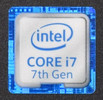
Despite the fast CPU, the Lenovo ThinkPad T470p is beaten by the Dell Latitude 5480, at least in the PCMark 8 results. Our test unit is left behind by around 7% and so has to be content with second place. Overall, all the comparison devices achieve a very good performance here, so that there are no large gaps between the devices.
Just by looking at the technical data, the system performance of the Lenovo ThinkPad T470p promises to be flawless. Subjectively, this is confirmed. Even if it wasn't enough for first place, working with the device is fun, and the hardware components are well adjusted, so that there are no latencies during work worth mentioning.
| PCMark 7 Score | 5766 points | |
| PCMark 8 Home Score Accelerated v2 | 3650 points | |
| PCMark 8 Creative Score Accelerated v2 | 4883 points | |
| PCMark 8 Work Score Accelerated v2 | 4654 points | |
Help | ||
Storage Solution
The storage in our test unit comes from Samsung. The fast, 512 GB SSD is connected via PCIe and offers additional security thanks to OPAL 2.0 support. According to AS SSD, at 1455 MB/s for sequential reads, we measure a very decent result. In sequential writes, the built-in SSD still achieves 1176 MB/s in the test. In the comparison, all three laptops with NVMe-SSDs can clearly break away from the devices that have an SSD with only SATA speeds.
Note:
Optionally, the Lenovo ThinkPad T470p can also be equipped with a storage component of the 2.5-inch format. Anyone who can forgo use of a WWAN module can use this M.2 slot also for an additional storage component if paying attention to its length (M.2 2242 form factor).
| Lenovo ThinkPad T470p-20J7S00000 Samsung PM961 NVMe MZVLW512HMJP | Lenovo ThinkPad T460p-20FXS05500 Samsung SSD PM871 MZ7LN512HCHP | Dell Latitude 14 E5470 Micron SSD 1100 (MTFDDAV256TBN) | Dell Latitude 5480 Toshiba SG5 256GB THNSNK256GVN8 | HP EliteBook 840 G4-Z2V49ET ABD Samsung PM961 MZVLW256HEHP | Lenovo ThinkPad T470-20HD002HGE Samsung PM961 NVMe MZVLW512HMJP | |
|---|---|---|---|---|---|---|
| CrystalDiskMark 3.0 | -49% | -60% | -55% | 8% | -6% | |
| Read Seq (MB/s) | 1088 | 502 -54% | 465.4 -57% | 469.4 -57% | 1819 67% | 1155 6% |
| Write Seq (MB/s) | 1023 | 442 -57% | 363.1 -65% | 264.8 -74% | 1263 23% | 1076 5% |
| Read 512 (MB/s) | 731 | 411.4 -44% | 338.4 -54% | 408.1 -44% | 922 26% | 811 11% |
| Write 512 (MB/s) | 798 | 414.3 -48% | 246.1 -69% | 265.5 -67% | 804 1% | 862 8% |
| Read 4k (MB/s) | 60.9 | 29.18 -52% | 25.83 -58% | 24.66 -60% | 61.4 1% | 55.5 -9% |
| Write 4k (MB/s) | 166.8 | 86.5 -48% | 80.3 -52% | 114.8 -31% | 157.1 -6% | 134.6 -19% |
| Read 4k QD32 (MB/s) | 652 | 358.1 -45% | 246.1 -62% | 380.3 -42% | 513 -21% | 496.2 -24% |
| Write 4k QD32 (MB/s) | 563 | 319.8 -43% | 197.7 -65% | 207.2 -63% | 410.2 -27% | 425.4 -24% |
Graphics Card
The Intel HD Graphics 630 primarily handles the screen output. Depending on demand, it clocks between 350 and 1100 MHz. Furthermore, it takes load off the processor in 2D operation and when playing videos. Besides the integrated graphics unit, our test sample also has an additional graphics card. Even though the Nvidia GeForce 940MX is not a newcomer, in combination with the strong processor it delivers a very good performance. At the time, we also tested the predecessor in the form of the Lenovo ThinkPad T460p with this combination. Nonetheless, the Lenovo ThinkPad T470p can clearly break off and leave all the competitors far behind in the last places in the synthetic benchmarks. The distance between the predecessor and our test unit is put slightly into perspective if you look at the Nvidia GeForce 940MX specifications more in detail. You should then notice that last year's model had the considerably slower DDR3 RAM graphics storage, whereas the Lenovo ThinkPad T470p is now equipped with the Nvidia GeForce 940MX that has the much faster GDDR5 RAM.
Further benchmarks of the Intel HD Graphics 630 as well as the Nvidia GeForce 940MX, can be found here.
| 3DMark 11 Performance | 3428 points | |
| 3DMark Ice Storm Standard Score | 36216 points | |
| 3DMark Cloud Gate Standard Score | 11802 points | |
| 3DMark Fire Strike Score | 2253 points | |
| 3DMark Fire Strike Extreme Score | 1089 points | |
| 3DMark Time Spy Score | 737 points | |
Help | ||
Gaming Performance
Even though the 3D performance in the synthetic benchmarks left a good impression, you should not expect too much from the Nvidia GeForce 940MX. Since this is primarily a business device, there should not be a price comparison to a pure gaming machine. In the games we tested, the Lenovo ThinkPad T470p achieved very good results compared to the devices that have only an integrated graphics unit. With older titles (for example, BioShock Infinite and Battlefield 4) our test unit achieves passable frame rates even in the High preset. With newer games, the Nvidia GeForce 940MX has a harder time and the frame rates start to drop. We recommend to anyone who wants to play games occasionally with the business companion to pick an HD resolution with a medium preset, while still needing to decide on the presets from one game to another.
| low | med. | high | ultra | |
|---|---|---|---|---|
| BioShock Infinite (2013) | 129.4 | 79.3 | 68.3 | 25.5 |
| Battlefield 4 (2013) | 98.8 | 69.1 | 48.8 | 19.8 |
| The Witcher 3 (2015) | 49.2 | 28.4 | 14.6 | |
| Rise of the Tomb Raider (2016) | 51.8 | 30.6 | 17 |
Emissions
Noise Emissions
During load, the Lenovo ThinkPad T470p runs minimally louder than the predecessor. Without load, the fan is often silent, starting to run only when more demands are put on the device. In the direct comparison to the other laptops in the test, the average noise emissions of the Lenovo ThinkPad T470p are slightly higher at 35.6 dB(A). Only the Dell Latitude 5480 is clearly louder at 42 dB(A). Our test unit reaches a maximum of 39.7 dB(A), which is clearly audible, but not yet interfering. In that case, the fan is running constantly and there are no great speed variations. During normal operation, the device only emits a slight whirring, which should be considered tolerable.
Noise level
| Idle |
| 29 / 29 / 29 dB(A) |
| Load |
| 35.6 / 39.7 dB(A) |
 | ||
30 dB silent 40 dB(A) audible 50 dB(A) loud |
||
min: | ||
| Lenovo ThinkPad T470p-20J7S00000 i7-7700HQ, GeForce 940MX | Lenovo ThinkPad T460p-20FXS05500 6700HQ, GeForce 940MX | Dell Latitude 14 E5470 6440HQ, HD Graphics 530 | Dell Latitude 5480 i7-7600U, HD Graphics 620 | HP EliteBook 840 G4-Z2V49ET ABD i5-7200U, HD Graphics 620 | Lenovo ThinkPad T470-20HD002HGE i5-7200U, HD Graphics 620 | |
|---|---|---|---|---|---|---|
| Noise | 1% | 1% | -9% | -1% | 6% | |
| off / environment * (dB) | 29 | 29.2 -1% | 30.3 -4% | 31 -7% | 28 3% | |
| Idle Minimum * (dB) | 29 | 29.2 -1% | 30.3 -4% | 29.6 -2% | 31 -7% | 28 3% |
| Idle Average * (dB) | 29 | 29.2 -1% | 30.3 -4% | 29.6 -2% | 31 -7% | 28 3% |
| Idle Maximum * (dB) | 29 | 29.2 -1% | 30.3 -4% | 29.6 -2% | 31 -7% | 29.4 -1% |
| Load Average * (dB) | 35.6 | 33.5 6% | 31.6 11% | 42 -18% | 33.5 6% | 31.4 12% |
| Load Maximum * (dB) | 39.7 | 38.8 2% | 35 12% | 47.1 -19% | 33.7 15% | 34.6 13% |
* ... smaller is better
Temperature
We mentioned the subject of temperature in connection with the Cinebench loop. We already saw then that with throttling the thermal limit of the processor is easily reached. But first a few words on the case temperatures of the Lenovo ThinkPad T470p. During idle operation, there are no complaints. At all measuring points, the temperatures remain clearly below the 30 °C (86 °F) mark. During load, the picture changes completely. In some spots we quickly reach 50 °C (122 °F) or more, which can become uncomfortable when using it on your lap. Now about the temperatures that develop inside under load: During the stress test with Prime95, the Intel Core i7-7700HQ quickly reaches the thermal limit of 100 °C (212 °F) and is throttled for its own protection. To be more exact, we measure temperatures of 99 °C and 98 °C (210 and 208 °F). Despite the beginning throttling, the CPU clocks at 3.2 GHz on average. During the stress test with the FurMark program, which mainly puts load on the GPU, the processor temperature still moves beyond the 90 °C (194 °F) mark easily.
At 82 °C (180 °F), the Nvidia GeForce 940MX does not really stay very cool and clocks at a continuous 1050 MHz during the test. If both programs are run at the same time, it creates hard work for the fan. Not surprisingly, at a maximum of 98 °C (208 °F), the CPU temperatures remain at the same level as before. The thermal load of the processor now also results in a GPU temperature that at 89 °C (192 °F) is considerably warmer than before and therefore the GPU needs to be throttled. Under this constant load, the clock speed is still acceptable at 1000 MHz. Right after the load test, we ran 3DMark 11 again, in order to test which disadvantages the continuous load brings to the results. The result is slightly surprising, since we cannot find a measurable disadvantage. Still, in our opinion the cooling system is overtaxed and the manufacturer should rethink it.
Note:
During this load test, the notebook repeatedly went into standby mode by itself, due to temperatures being too high. Right after it had turned off, we restarted the device to continue the load test.
(-) The maximum temperature on the upper side is 50.2 °C / 122 F, compared to the average of 34.3 °C / 94 F, ranging from 21.2 to 62.5 °C for the class Office.
(-) The bottom heats up to a maximum of 51.3 °C / 124 F, compared to the average of 36.8 °C / 98 F
(+) In idle usage, the average temperature for the upper side is 25.4 °C / 78 F, compared to the device average of 29.5 °C / 85 F.
(±) The palmrests and touchpad can get very hot to the touch with a maximum of 38.5 °C / 101.3 F.
(-) The average temperature of the palmrest area of similar devices was 27.6 °C / 81.7 F (-10.9 °C / -19.6 F).
| Lenovo ThinkPad T470p-20J7S00000 i7-7700HQ, GeForce 940MX | Lenovo ThinkPad T460p-20FXS05500 6700HQ, GeForce 940MX | Dell Latitude 14 E5470 6440HQ, HD Graphics 530 | Dell Latitude 5480 i7-7600U, HD Graphics 620 | HP EliteBook 840 G4-Z2V49ET ABD i5-7200U, HD Graphics 620 | Lenovo ThinkPad T470-20HD002HGE i5-7200U, HD Graphics 620 | |
|---|---|---|---|---|---|---|
| Heat | -11% | -1% | 11% | 15% | 14% | |
| Maximum Upper Side * (°C) | 50.2 | 51.6 -3% | 43 14% | 36.4 27% | 37 26% | 37.2 26% |
| Maximum Bottom * (°C) | 51.3 | 55.2 -8% | 43 16% | 45 12% | 39.4 23% | 45.1 12% |
| Idle Upper Side * (°C) | 26.3 | 30.7 -17% | 31.2 -19% | 26.4 -0% | 25.9 2% | 24.4 7% |
| Idle Bottom * (°C) | 27.5 | 31.5 -15% | 31.3 -14% | 26.8 3% | 25.6 7% | 25 9% |
* ... smaller is better
Speakers
There is nothing new in the built-in stereo speakers, which are the same as in the predecessor. Accordingly we find the same advantages and disadvantages in the Lenovo ThinkPad T470p again. For video-calling, music, or videos, the small membranes are sufficient. Due to the small dimensions, the bass is lacking in the sound and the highs and mids dominate. The maximum volume of 83 dB(A) is still sufficient for larger rooms. There are no noticeable distortions even at higher volumes. You can connect external speakers via 3.5-mm connectors or USB.
Lenovo ThinkPad T470p-20J7S00000 audio analysis
(+) | speakers can play relatively loud (83.1 dB)
Bass 100 - 315 Hz
(-) | nearly no bass - on average 18.1% lower than median
(±) | linearity of bass is average (14.6% delta to prev. frequency)
Mids 400 - 2000 Hz
(+) | balanced mids - only 4.2% away from median
(+) | mids are linear (5.9% delta to prev. frequency)
Highs 2 - 16 kHz
(+) | balanced highs - only 3.3% away from median
(+) | highs are linear (6.5% delta to prev. frequency)
Overall 100 - 16.000 Hz
(±) | linearity of overall sound is average (19.6% difference to median)
Compared to same class
» 39% of all tested devices in this class were better, 8% similar, 53% worse
» The best had a delta of 7%, average was 21%, worst was 53%
Compared to all devices tested
» 48% of all tested devices were better, 7% similar, 44% worse
» The best had a delta of 4%, average was 24%, worst was 134%
Apple MacBook 12 (Early 2016) 1.1 GHz audio analysis
(+) | speakers can play relatively loud (83.6 dB)
Bass 100 - 315 Hz
(±) | reduced bass - on average 11.3% lower than median
(±) | linearity of bass is average (14.2% delta to prev. frequency)
Mids 400 - 2000 Hz
(+) | balanced mids - only 2.4% away from median
(+) | mids are linear (5.5% delta to prev. frequency)
Highs 2 - 16 kHz
(+) | balanced highs - only 2% away from median
(+) | highs are linear (4.5% delta to prev. frequency)
Overall 100 - 16.000 Hz
(+) | overall sound is linear (10.2% difference to median)
Compared to same class
» 7% of all tested devices in this class were better, 2% similar, 91% worse
» The best had a delta of 5%, average was 18%, worst was 53%
Compared to all devices tested
» 4% of all tested devices were better, 1% similar, 94% worse
» The best had a delta of 4%, average was 24%, worst was 134%
Frequency diagram in comparison (checkboxes above can be checked/unchecked!)
Power Management
Power Consumption
Compared to the Lenovo ThinkPad T460p, the overall consumption was lowered by 22%. Since the rest of the comparison devices are equipped with very efficient components to some extent and do without dedicated graphics GPUs, they fare well, as expected. Without load, the Lenovo ThinkPad T470p indulges in 3.8 to 7.2 Watt on average. In this area especially, there was improvement compared to the predecessor. Under load, the combination of the powerful CPU and GPU ensures a considerable increase. We measure the top consumption of the Lenovo ThinkPad T470p at a 99.6 Watt maximum (reduced clearly with beginning throttling). If the device is turned off or in standby mode, the power consumption is at 0.2 and 0.35 Watt respectively.
At a maximum of 135 Watt, the power supply can offer sufficient power.
| Off / Standby | |
| Idle | |
| Load |
|
Key:
min: | |
| Lenovo ThinkPad T470p-20J7S00000 i7-7700HQ, GeForce 940MX, Samsung PM961 NVMe MZVLW512HMJP, IPS, 2560x1440, 14" | Lenovo ThinkPad T460p-20FXS05500 6700HQ, GeForce 940MX, Samsung SSD PM871 MZ7LN512HCHP, IPS-Panel, 2560x1440, 14" | Dell Latitude 14 E5470 6440HQ, HD Graphics 530, Micron SSD 1100 (MTFDDAV256TBN), AH-IPS, WLED, 1920x1080, 14" | Dell Latitude 5480 i7-7600U, HD Graphics 620, Toshiba SG5 256GB THNSNK256GVN8, IPS, 1920x1080, 14" | HP EliteBook 840 G4-Z2V49ET ABD i5-7200U, HD Graphics 620, Samsung PM961 MZVLW256HEHP, TN, 1920x1080, 14" | Lenovo ThinkPad T470-20HD002HGE i5-7200U, HD Graphics 620, Samsung PM961 NVMe MZVLW512HMJP, IPS, 1920x1080, 14" | |
|---|---|---|---|---|---|---|
| Power Consumption | -22% | 1% | 7% | 29% | 29% | |
| Idle Minimum * (Watt) | 3.8 | 5 -32% | 4.1 -8% | 6.64 -75% | 2.9 24% | 3.21 16% |
| Idle Average * (Watt) | 6.5 | 9.9 -52% | 8.1 -25% | 6.67 -3% | 5.6 14% | 6.15 5% |
| Idle Maximum * (Watt) | 7.2 | 10.8 -50% | 11.4 -58% | 7.78 -8% | 8.15 -13% | 6.82 5% |
| Load Average * (Watt) | 62.5 | 52.4 16% | 33.5 46% | 30.83 51% | 30.6 51% | 28.5 54% |
| Load Maximum * (Watt) | 99.6 | 89.8 10% | 49 51% | 31.7 68% | 31 69% | 34.5 65% |
* ... smaller is better
Battery Life
Our test unit is equipped with the largest battery available for this device. The lithium-ion battery that has 72 Wh can be easily removed and replaced. Alternatively, the Lenovo ThinkPad T470p can also be purchased with a smaller 47-Wh battery. Accordingly, the runtimes will then be considerably shorter than we specified here. Without load, our test unit will keep its lights on for 17:39 hours. Unfortunately, under load, however, the battery is already empty after 82 minutes, which is mainly due to the power-hungry processor.
Our WLAN test is more practically relevant. Based on scripts, various websites are opened at 30-second intervals. The "Balanced" power profile is active and the display brightness is adjusted to 150 cd/m², which corresponds to a reduction of brightness by three steps in our test unit. Our Lenovo ThinkPad T470p achieved a runtime of a good 10 hours, which should easily last for a whole workday. Playing videos, the battery lasts for 7:38 hours. With this, nothing should stand in the way of a prolonged evening of watching movies, which again shows the good multimedia characteristics of the Lenovo ThinkPad T470p. Even in battery operation, the 3D performance is not reduced and the score of the 3DMark 11 test we ran again is identical to the previous results.
| Lenovo ThinkPad T470p-20J7S00000 i7-7700HQ, GeForce 940MX, 72 Wh | Lenovo ThinkPad T460p-20FXS05500 6700HQ, GeForce 940MX, 48 Wh | Dell Latitude 14 E5470 6440HQ, HD Graphics 530, 62 Wh | Dell Latitude 5480 i7-7600U, HD Graphics 620, 68 Wh | HP EliteBook 840 G4-Z2V49ET ABD i5-7200U, HD Graphics 620, 51 Wh | Lenovo ThinkPad T470-20HD002HGE i5-7200U, HD Graphics 620, 48 Wh | |
|---|---|---|---|---|---|---|
| Battery runtime | -35% | -13% | 63% | 39% | 13% | |
| Reader / Idle (h) | 17.7 | 11 -38% | 15.2 -14% | 24.1 36% | 19.3 9% | |
| H.264 (h) | 7.6 | 6 -21% | 6.9 -9% | 9.9 30% | 10.4 37% | |
| WiFi v1.3 (h) | 10 | 5 -50% | 7.2 -28% | 16.1 61% | 9.5 -5% | 7.3 -27% |
| Load (h) | 1.4 | 1 -29% | 1.4 0% | 2.7 93% | 3.1 121% | 1.8 29% |
Verdict
Pros
Cons
Lenovo updates their models and provides the ThinkPad T470p with a very powerful Kaby Lake CPU, the performance of which is more than enough for the envisioned usages in any regard. The memory (8 GB DDR4), which is not ample but sufficient, can be extended anytime if necessary. We like all the security features that turn the Lenovo ThinkPad T470p into a business device. Nonetheless the manufacturer also provides the work horse with a dedicated GPU, which is capable of bringing some games to the screen at passable frame rates. The storage solution offers a very good performance and contributes significantly to a smoothly running system. However, the bottom line is always the price, which at 2099 Euros (~$2367) is considerable for this device. For this amount you get a high-performance business notebook in the 14-inch format, which is once again equipped with very good input devices.
However, the Lenovo ThinkPad T470p still deserves some complaints: Even though the display offers a solid performance, in terms of brightness it remains behind the expectations. We have no sympathy for Lenovo not supplying a new device, which is supposed to be used for a few years, with modern connectors. For this price, you should get at least a USB 3.1 Type-C port that supports Thunderbolt. Finally, the cooling performance should also be improved in the successor.
As a high-performance quad-core racer in the 14-inch format, the T470p has really unique features at this current time.
Overall, the Lenovo ThinkPad T470p leaves a good impression. The excellent system performance and dedicated GPU strengthen the device and enable versatile usage scenarios. Besides work at the office, the Lenovo ThinkPad T470p also handles multimedia tasks very well, and even some games can be played on it without any problem.
Lenovo ThinkPad T470p-20J7S00000
- 05/14/2017 v6 (old)
Sebastian Bade




